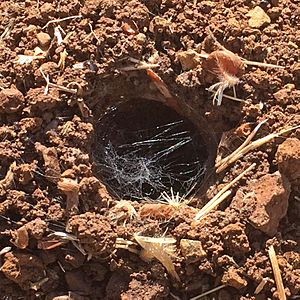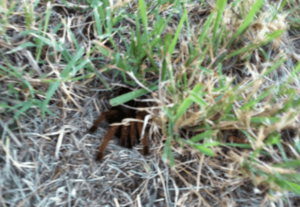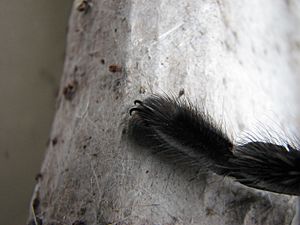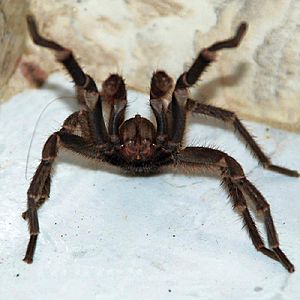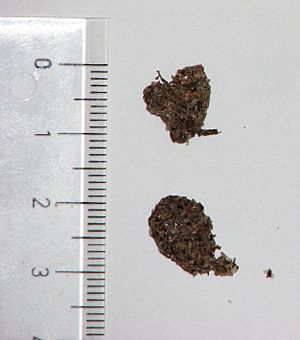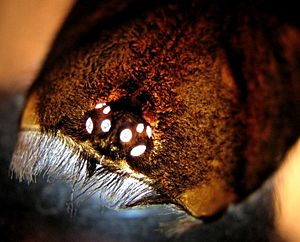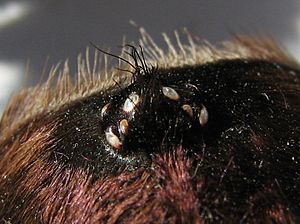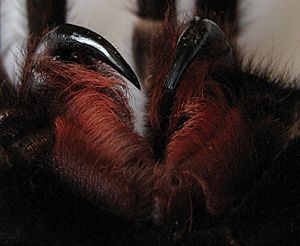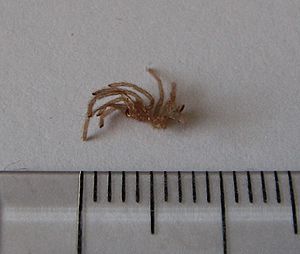Tarantula facts for kids
Quick facts for kids Tarantula |
|
|---|---|
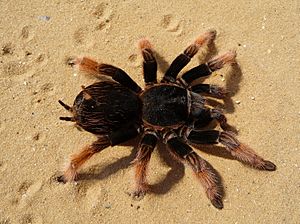 |
|
| Mexican pink tarantula, Brachypelma klaasi | |
| Scientific classification |
|
| Kingdom: | Animalia |
| Phylum: | Arthropoda |
| Subphylum: | Chelicerata |
| Class: | Arachnida |
| Order: | Araneae |
| Infraorder: | Mygalomorphae |
| Clade: | Avicularioidea |
| Family: | Theraphosidae Thorell, 1869 |
| Diversity | |
| 148 genera, 1,236 species | |
 |
|
Tarantulas are large, often hairy spiders. They belong to the family Theraphosidae. As of August 2022, scientists have found 1,040 different kinds (species) of tarantulas. These species are grouped into 156 different types (genera).
Some tarantulas are popular as exotic pets. Many tarantulas from the Americas have special hairs called urticating hairs. These hairs can irritate skin. In rare cases, they can even harm eyes.
Contents
Discovering Tarantulas
Tarantulas are invertebrates. This means they do not have a backbone. They have a hard outer shell called an exoskeleton. This shell helps support their muscles.
How Big Are Tarantulas?
Tarantulas come in many sizes. Some are as small as a BB pellet. Others can be as big as a dinner plate when their legs are stretched out. Their bodies can be from 5 to 11 centimeters (2 to 4.5 inches) long. Their leg span can be from 8 to 30 centimeters (3 to 12 inches). We measure leg span from the tip of a back leg to the tip of the front leg on the opposite side.
The biggest tarantulas can weigh over 85 grams (3 ounces). The largest of all is the goliath birdeater. This tarantula lives in Venezuela and Brazil. It can weigh up to 170 grams (6 ounces). Its leg span can reach 30 centimeters (12 inches). Male goliath birdeaters are longer. Females are usually wider. Their fangs can be as long as 4 centimeters (1.5 inches).
The goliath birdeater (Theraphosa blondi) is thought to be the heaviest tarantula. Another species, T. apophysis, has the longest leg span. Two other large species are the Brazilian salmon birdeater (Lasiodora parahybana) and Lasiodora klugi. They are almost as big as the goliath spiders.
What Colors Are They?
Most tarantulas in North America are brown. But tarantulas around the world come in many colors. Some are cobalt blue (Cyriopagopus lividus). Others are black with white stripes (Aphonopelma seemanni). Some have yellow leg markings (Eupalaestrus campestratus). There are even tarantulas with metallic blue legs, bright orange bodies, and green heads (Chromatopelma cyaneopubescens).
Where Do Tarantulas Live?
Tarantulas live in many different places. These include savannas, grasslands, rainforests, and deserts. They also live in scrublands, mountains, and cloud forests. Most tarantulas live on the ground. They dig burrows (holes) in the earth to live in.
Tarantulas are becoming popular pets. Some species are easy to find for keeping at home.
The Name "Tarantula"
The name "tarantula" first came from a different spider. This spider was Lycosa tarantula, a type of wolf spider. It lived in southern Europe, near the town of Taranto in Italy. Later, people started calling almost any large, unfamiliar spider that lived on the ground a "tarantula."
Where Tarantulas Are Found
Different kinds of tarantulas live all over the United States and Mexico. They are also found throughout Central America and South America. Other species live across Africa and much of Asia. This includes the Ryukyu Islands in southern Japan. They also live all over Australia. In Europe, some species are found in Spain, Portugal, Turkey, southern Italy, and Cyprus.
Tarantula Habits
Some tarantulas hunt for food mainly in trees. Others hunt on or near the ground. All tarantulas can make silk. Tarantulas that live in trees often make a silk "tube tent" to live in. Tarantulas that live on the ground line their burrows with silk. This makes the burrow walls stronger. It also helps them climb up and down easily.
What Do Tarantulas Eat?
Tarantulas mostly eat large insects and other arthropods. These include centipedes, millipedes, and other spiders. They usually catch their prey by surprise (ambush). Tarantulas have strong jaws called chelicerae. These jaws have long, hard fangs. This helps them kill other large arthropods. The biggest tarantulas can even catch and eat small animals. These might include lizards, mice, bats, birds, and small snakes.
Tarantula Body Parts
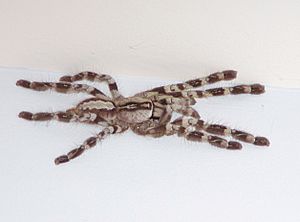
A tarantula has four pairs of legs. It also has two other pairs of body parts. Each leg has seven sections. At the end of each leg are two or three claws. These claws help the tarantula grip surfaces for climbing. Around the claws are special bristles called scopula. They help the tarantula grip smooth surfaces like glass.
The fifth pair of body parts are the pedipalps. These help the tarantula feel things and grip its prey. For adult males, they also help with mating. The sixth pair are the chelicerae, which have the fangs attached.
When a tarantula walks, its first and third legs on one side move with the second and fourth legs on the other side. Tarantulas bend their legs using muscles. To straighten a leg, they increase the pressure of their body fluid (called haemolymph) into the leg.
Tarantulas have spinnerets at the end of their body (opisthosoma). These are flexible, tube-like parts. They push out silk from these spinnerets. Unlike most spiders, tarantulas have two or four spinnerets. Each spinneret has many tiny tubes that release silk. As the silk is pulled out, it changes from a liquid to a solid thread.
How Tarantulas Digest Food
A tarantula's mouth is at the front of its head area (prosoma). The mouth is a short, straw-shaped opening. It can only suck liquids. Any solid food must be crushed and turned into liquid. Tarantulas do this by covering their prey with digestive juices. These juices come from openings in their jaws (chelicerae).
The tarantula's stomach is a tube that runs through its body. Once the liquid food enters, it breaks down into tiny pieces. These pieces then pass into the tarantula's blood (hemolymph). The blood carries the nutrients all over the body. After eating, the tarantula forms any leftover solid parts into a small ball. Then it throws this ball away.
Tarantula Senses
A tarantula's brain is in the lower front part of its head area (prosoma). Tarantulas have eight eyes, like most spiders. But they mostly use vibrations to hunt. They feel the movements of their prey. Tarantulas have very sensitive hairs (setae) on their bodies. These hairs help them sense chemicals, vibrations, and wind direction. They might even help them hear sounds. Tarantulas also react strongly to certain chemicals, like pheromones.
Their eyes are above their jaws (chelicerae) on the front of the prosoma. They are small and usually in two rows of four. Most tarantulas can only see light, darkness, and movement. Tarantulas that live in trees usually have better eyesight than those that live on the ground.
How Tarantulas Breathe
All tarantulas have two sets of book lungs. These are their breathing organs. The first pair is in a space inside the lower front part of their body (abdomen). The second pair is a little further back. Each lung has about 15 thin sheets of folded tissue. These sheets look like the pages of a book. Blood vessels supply these tissues. As air enters the lungs, oxygen goes into the blood. These organs can also take in moisture from humid air.
Tarantula Blood
A tarantula's blood is special. It is not like human blood. It is a liquid called hemolymph. It contains different types of cells called hemocytes.
If a tarantula's outer shell (exoskeleton) breaks, it can lose hemolymph. Losing too much hemolymph can kill the spider. But if the wound is small, the hemolymph can dry and seal it.
Who Hunts Tarantulas?
Even though tarantulas are big and look scary, many animals hunt them. The most specialized hunters are large wasps from the family Pompilidae. These wasps are called "tarantula hawks."
Many other animals also eat tarantulas. These include lizards, frogs, birds, snakes, and mammals. These animals often eat all kinds of large insects and spiders. Mammals known to eat tarantulas include the coati, kinkajou, and opossum in the Americas. In other parts of the world, mongooses and the honey badger eat them. These mammals are often not harmed by the tarantula's venom.
Humans also eat tarantulas in some places. They are a special food in cultures like those in Venezuela and Cambodia. People can roast them over a fire to remove their bristles before eating.
Tarantula Bites and Hairs
All tarantulas have venom. Their venom is not deadly to humans. But some bites can cause a lot of discomfort for several days. We don't know much about the effects of most tarantula bites. Many species have bites no worse than a wasp sting. But some species are reported to cause very painful bites. These can lead to strong muscle spasms that last for days. The venom of the African tarantula Pelinobius muticus can even cause strong hallucinations.
Before biting, a tarantula might show it plans to attack. It will stand in a "threat posture." This means it raises its front body (prosoma) and front legs. It spreads its fangs. Some species might even make a loud hissing sound. Tarantulas often stay in this position for a long time. If this doesn't scare away the threat, they might slap down with their raised front legs.
If the attacker is still there, tarantulas from the Americas might turn away. Then they flick urticating hairs toward the predator. Their next move might be to run away. But if they can't escape, they might suddenly turn and bite. Some tarantulas give "dry bites." This means they bite defensively but do not inject venom.
Tarantula Life Cycle
Like other spiders, tarantulas must shed their outer skin (exoskeleton) as they grow. This process is called molting. Young tarantulas molt several times a year as they get bigger. Adult tarantulas molt once a year or less. They might molt sooner to replace lost legs or hairs.
You can tell a tarantula is about to molt when its exoskeleton gets darker. If a tarantula has used its urticating hairs, the bald spot on its body turns from peach to deep blue. The tarantula also stops eating and becomes less active.
Most tarantula species take two to five years to become adults. Some can take up to 10 years. Once male tarantulas become adults, they usually only live for about 18 more months. So, they immediately look for a female to mate with. Female tarantulas keep molting after they become adults. Males rarely molt again once they are fully grown. If a male does try to molt again, it can get stuck and die.
Female tarantulas can live for 30 to 40 years. Some Grammostola rosea spiders, which eat once or twice a week, have lived up to 20 years in captivity. Some have even survived for up to two years on water alone.
Tarantula Reproduction
After becoming an adult, a female tarantula usually mates and lays eggs once a year. However, they don't always do this.
Females lay 50 to 2,000 eggs. The number depends on the species. They put the eggs in a silk egg sac. They guard this sac for six to eight weeks. During this time, females stay very close to their egg sacs. They also become more aggressive. In most species, females turn the egg sac often. This is called brooding. It stops the eggs from getting squashed by staying in one spot too long. The young spiderlings stay in the nest for a while after hatching. They live off the food from their yolk sacs before they spread out.
Tarantula Fossils
Fossils of spiders like tarantulas (mygalomorphs) have been found from as far back as the Triassic period. But only two fossils have been clearly identified as tarantulas so far. One was found in Dominican Republic amber. The other was found in Chiapas (Mexico) amber. Both of these amber pieces are quite new. They are from the Miocene age, about 16 million years ago.
Images for kids
See also
 In Spanish: Terafósidos para niños
In Spanish: Terafósidos para niños


